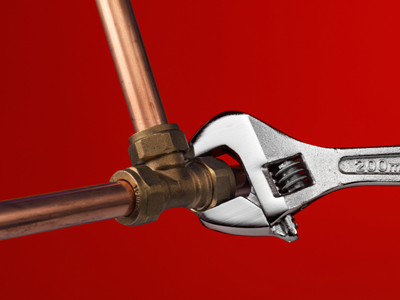
Ask the AI Tutor
Need help with Chemistry - Physical Properties and Uses of Metals (AQA)? Ask our AI Tutor!
AI Tutor - Lucy
Connecting with Tutor...
Please wait while we establish connection

Copper has many uses, one of which is to make pipes for carrying water.
Chemistry - Physical Properties and Uses of Metals (AQA)
Metals have different physical properties, such as strength, density and melting point. These properties decide which metal we choose for wires, bridges, vehicles and food packaging.
1 .
Why are the metals magnesium and titanium used to make alloys for aircraft frames?
They are light metals
They are heavy metals
They are transition metals
They are silver coloured metals
When they are alloyed with aluminium, they form light but extremely strong alloys
2 .
Many people who ride mountain bikes buy parts made from titanium alloys. Which of the following is not a practical reason for making this choice?
Titanium alloys are lightweight
Titanium alloys have a high melting point
Titanium alloys are durable
Titanium alloys are resistant to metal fatigue
Titanium alloys are particularly of interest to racing cyclists who need tough, reliable and lightweight parts for their bikes. The melting point is of no concern to them at all!
3 .
Which of the following metals would be suitable for making a hammer?
Steel
Cast iron
Copper
Titanium
Cast iron is too brittle and would break, copper is too soft and titanium would be too expensive
4 .
Aluminuim is not as good a conductor of electricity as copper so why is it used for making the electrical cables for the National Grid?
It is easier than copper to make it into wires
It doesn't expand or contract
It is silver coloured so birds and pilots can see and avoid the cables
The density of aluminium is less than that of copper
There are several reasons but one of the important ones is that cables carrying electricity in the National Grid need to be large and therefore will be heavy. Using a low density metal like aluminium keeps the weight down as far as possible
5 .
Which of the following is not a physical property of titanium?
Low density
Corrosion resistant
Conducts electricity
Very strong
Corrosion resistance is a chemical property
6 .
House electrical systems require a good earthing system to make them safe. The earthing system carries electricity safely into the ground and causes the safety devices in the house to 'trip', preventing electric shocks. Electricians sometimes fix the earth wires of a domestic electrical system to copper pipes used for the plumbing. Why is this?
The water in the pipe conducts electricity to earth
Copper is a good conductor of electricity
The pipes will stay cool in the event of an electrical emergency
It is an easy thing to do and saves them the time and trouble of putting a proper system in place
Water pipes are buried in the ground. Copper is a very good electrical conductor. Putting the two together makes a good way of providing an earthing system for older houses in particular. In newer houses that use plastic for the plumbing, a different system is used
7 .
Why can metals be bent and pulled into shape?
The atoms of metals are soft
The layers of metal ions are able to slide over and past each other
The ions of a metal are able to break free of each other
They are ionically bonded
We say metals are ductile (can be pulled into shape) and malleable (can be hammered or bent into shape)
8 .
Why do metals conduct electricity?
They have ionic bonds
They have covalent bonds
They have free electrons
The layers of ions in a metal
Some of the atoms in a metal lose an electron from their outermost energy level (shell) and these are free to move through the structure. Electricity is a flow of electrons
9 .
Tungsten is a transition metal that is used for making the filaments of some electric light bulbs. What is the most likely reason for this?
Tungsten has a high density
Tungsten has a high boiling point
Tungsten has a high melting point
Tungsten is very cheap
Tungsten isn't one of the metals that you are required to know about but the examiners will often throw in questions about materials that you don't know. They are testing to see if you can make logical choices using what you know about the physIcal properties of metals being linked to their uses
10 .
Steel corrodes but it is still the best metal for making car bodies. Why is this?
Steel is shiny and makes cars look good
Steel conducts electricity
Steel conducts heat well
Steel is strong and malleable
A car body needs to be able to protect the occupants and to be easy to shape
**Unlimited Quizzes Await You! 🚀**
Hey there, quiz champ! 🌟 You've already tackled today's free questions.
Ready for more?
Ready for more?
🔓 Unlock UNLIMITED Quizzes and challenge yourself every day. But that's
not all...
not all...
🔥 As a Subscriber you can join our thrilling "Daily Streak" against other
quizzers. Try to win a coveted spot on our Hall of Fame Page.
quizzers. Try to win a coveted spot on our Hall of Fame Page.
Don't miss out! Join us now and keep the fun rolling. 🎉
**Unlimited Quizzes Await You! 🚀**
Hey there, quiz champ! 🌟 You've already tackled today's free questions. Ready for more?
🔓 Unlock UNLIMITED Quizzes and challenge yourself every day. But that's not all...
🔥 As a Subscriber you can join our thrilling "Daily Streak" against other quizzers. Try to win a coveted spot on our Hall of Fame Page.
Don't miss out! Join us now and keep the fun rolling. 🎉






